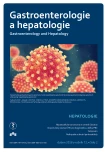-
Medical journals
- Career
A rare cause of increased abdominal size
Authors: K. Dvořák 1; J. Fulík 2
Authors‘ workplace: Oddělení gastroenterologie a hepatologie, Krajská nemocnice Liberec, a. s., Nemocnice Liberec 1; Chirurgická klinika 1. LF UK a IPVZ Nemocnice Na Bulovce, Praha 2
Published in: Gastroent Hepatol 2018; 72(2): 119-121
Category: Hepatology: Case Report
doi: https://doi.org/10.14735/amgh2018119Overview
We present a patient with an increased abdominal size and epigastric pain. Pseudomyxoma peritonei was diagnosed based on imaging studies. This is a rare clinical condition characterized by diffuse gelatinous collections in the abdomen and pelvis that are associated with mucinous implants on surfaces in the peritoneal cavity. It is caused by cystadenoma of the appendix, which leads to peritoneal seeding of mucus-producing cells. Mucins fill the peritoneal cavity. This condition has an indolent but progressive course and is fatal if untreated. The treatment of choice is radical surgical cytoreduction and heated intraperitoneal chemotherapy, which may have curative potential.
Key words:
pseudomyxoma peritonei – cystadenoma of the appendix – cytoreduction – HIPEC
The authors declare they have no potential conflicts of interest concerning drugs, products, or services used in the study.
The Editorial Board declares that the manuscript met the ICMJE „uniform requirements“ for biomedical papers.Submitted:
26. 3. 2018Accepted:
28. 3. 2018
Sources
1. Sugarbaker PH, Ronnett BM, Archer A et al. Pseudomyxoma peritonei syndrome. Adv Surg 1996; 30 : 233–280.
2. Ronnett BM, Zahn CM, Kurman RJ et al. Disseminated peritoneal adenomucinosis and peritoneal mucinous carcinomatosis. A clinicopathologic analysis of 109 cases with emphasis on distinguishing pathologic features, site of origin, prognosis, and relationship to „pseudomyxoma peritonei“. Am J Surg Pathol 1995; 19 (12): 1390–1408.
3. Hinson FL, Ambrose NS. Pseudomyxoma peritonei. Br J Surg 1998; 85 (10): 1332–1339.
4. Yalcin S, Ergül E, Korukluoglu B et al. Pseudomyxoma peritonei: what do we have? Int J Surg 2007; 15 (1): 1–9.
5. Psár R, Kala Z, Krátký J. Diferenciální diagnostika peritoneálních cystických lézí se zřetelem na pseudomyxom peritonea a echinokokovou cystu. Ces Radiol 2017; 71 (1): 74–78.
6. Levy D, Shaw J, Sobin L. Secondary tumors and tumorlike lesions of the peritoneal cavity: imaging features with pathologic correlation. Radiographics 2009; 29 : 347–373. doi: 10.1148/rg.292085189.
7. Hanbidge AE, Lynch D, Wilson SR. US of the peritoneum. Radiographics 2003; 23 (3): 663–684. doi: 10.1148/rg.233025712.
8. Los G, Verdegaal EM, Mutsaers PH et al. Penetration of carboplatin and cisplatin into rat peritoneal tumor nodules after intraperitoneal chemotherapy. Cancer Chemother Pharmacol 1991; 28 (3): 159–165.
9. Sugarbaker PH. Managing the peritoneal surface component of gastrointestinal cancer. Part 1. Patterns of dissemination and treatment options. Oncology (Williston Park) 2004; 18 (1): 51–59.
10. Chua TC, Moran BJ, Sugarbaker PH et al. Early-and long-term outcome data of patients with pseudomyxoma peritonei from appendiceal origin treated by a strategy of cytoreductive surgery and hyperthermic intraperitoneal chemotherapy. J Clin Oncol 2012; 30 (20): 2449–2456. doi: 10.1200/JCO.2011.39. 7166.
Labels
Paediatric gastroenterology Gastroenterology and hepatology Surgery
Article was published inGastroenterology and Hepatology

2018 Issue 2-
All articles in this issue
- Acute kidney injury in patients with acute pancreatitis
- Treatment of an adenoma of the ascending colon with the non-lifting sign via a combination of endoscopic mucosal resection and full-thickness resection
- Sleeve gastrectomy – a popular bariatric method to treat severe obesity and type 2 diabetes
- Esomeprazole – S-isomer of omeprazole with more favorable pharmacological properties and stronger pharmacodynamic effect
- Gastrointestinal symptomatology of familial Mediterranean fever – is this a problem also in Central Europe?
- Anniversary of Professor Zdenek Marecek
- View of the XXIIIrd Gastroforum, Strbske Pleso, 2018
- 6th Conference of Central European Hepatologic Col laboration
- The selection from international journals
- Hepatology
- Guidelines of the Czech Society of Hepatology for diagnosis and treatment of primary biliary cholangitis
- A rare cause of increased abdominal size
- Terlipressin remains indispensable in two indications
- Treatment of complicated Crohn’s disease with vedolizumab
- Hepatic cyst infection as a source of sepsis in liver polycystosis
- Hepatocellular carcinoma in central Slovakia – tertiary referral centre experience with 207 patients
- Gastroenterology and Hepatology
- Journal archive
- Current issue
- Online only
- About the journal
Most read in this issue- Terlipressin remains indispensable in two indications
- Guidelines of the Czech Society of Hepatology for diagnosis and treatment of primary biliary cholangitis
- Hepatic cyst infection as a source of sepsis in liver polycystosis
- A rare cause of increased abdominal size
Login#ADS_BOTTOM_SCRIPTS#Forgotten passwordEnter the email address that you registered with. We will send you instructions on how to set a new password.
- Career

